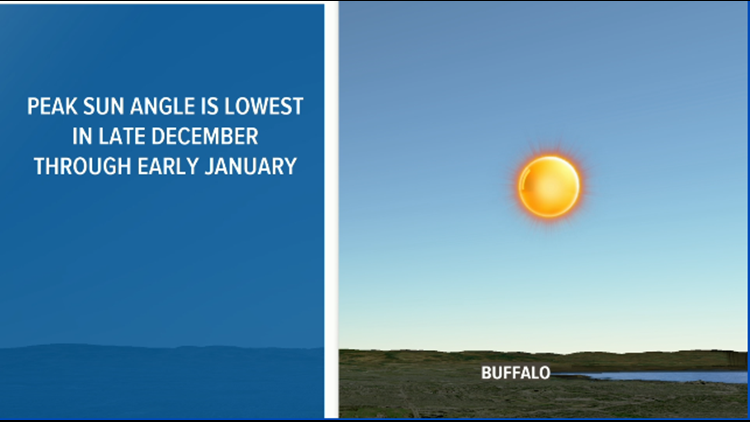BUFFALO, N.Y. — Our Christmas storm brought quite a bit of snow to most of Western New York. And most of it was gone within a week. There were several days above freezing, but never anything warmer than the low 40s.
There were also a few rounds of rain. Both of those things ate away at the snow base, but let’s go over all of the weather factors in play when it comes to snow melt.
The first factor is the most obvious: temperature. If the thermometer reads higher than 32 degrees, snow is going to melt day or night. The warmer the air is, the faster the snow melts. No kidding.
RELATED: Can it be too cold to snow?
Factor number two is sunshine or more accurately sunlight. Even with thin clouds, energy coming in from the sun during the day works to melt snow little by littler. A clear sky will melt snow faster, though.
What’s cool about sunlight is that it can melt snow even if temperatures are well below freezing. That’s especially true during the late fall and early spring when the sun reaches a higher point in the sky. This time of year, the sun is at its lowest point, but it still has some influence.
RELATED: Making strides towards spring
The next two snow eating weather factors are a little more obscure: wind and, believe it or not, fog.
When most think of wind, especially in winter, they think of wind chill or moving air being colder. And it may feel cooler to us, but that wind can actually keep a steady supply of milder air working over a snowpack. On a day without wind, air with temperatures higher than the snow will melt some of the snow, but the longer it sits, the more the snow also works to cool the surrounding air, making it melt less efficiently.


With a breeze, milder air can continually move in and replace the “old" air. The wind itself doesn’t blow away the snow, but it does make the air above it a more efficient "melter".
RELATED: Different ways fog can form
RELATED: When fog turned deadly
Fog’s method of melting requires a slightly deeper dig into science. Fog develops when air at the surface reaches saturation. That means the temperature and the dew point are about equal and gaseous water vapor particles that are always present condense into tiny water droplets.
The process of condensation is “exothermic,” meaning it releases a tiny bit of energy as heat. That released heat is called “latent heat” and fog has plenty of it, though don’t expect a tangible difference for yourself. It’s just enough extra warmth to eat away at snow a little faster than dry air would at the same temperature.
New episodes of Heather’s Weather Whys are posted to the WGRZ YouTube channel every Wednesday evening. If you have a weather question for Heather to answer, send it to her at heather.waldman@wgrz.com or connect with her on Facebook or Twitter.



